Leadership Strategies: Coaching, Feedback, and Rewards
VerifiedAdded on 2021/04/24
|11
|2348
|35
Report
AI Summary
This report analyzes the significance of coaching conversations, feedback mechanisms, and employee recognition within a leadership context, drawing on a case study of a Project Manager at Canadian Tire. It explores the implementation and outcomes of a coaching system, including the six-cap coac...
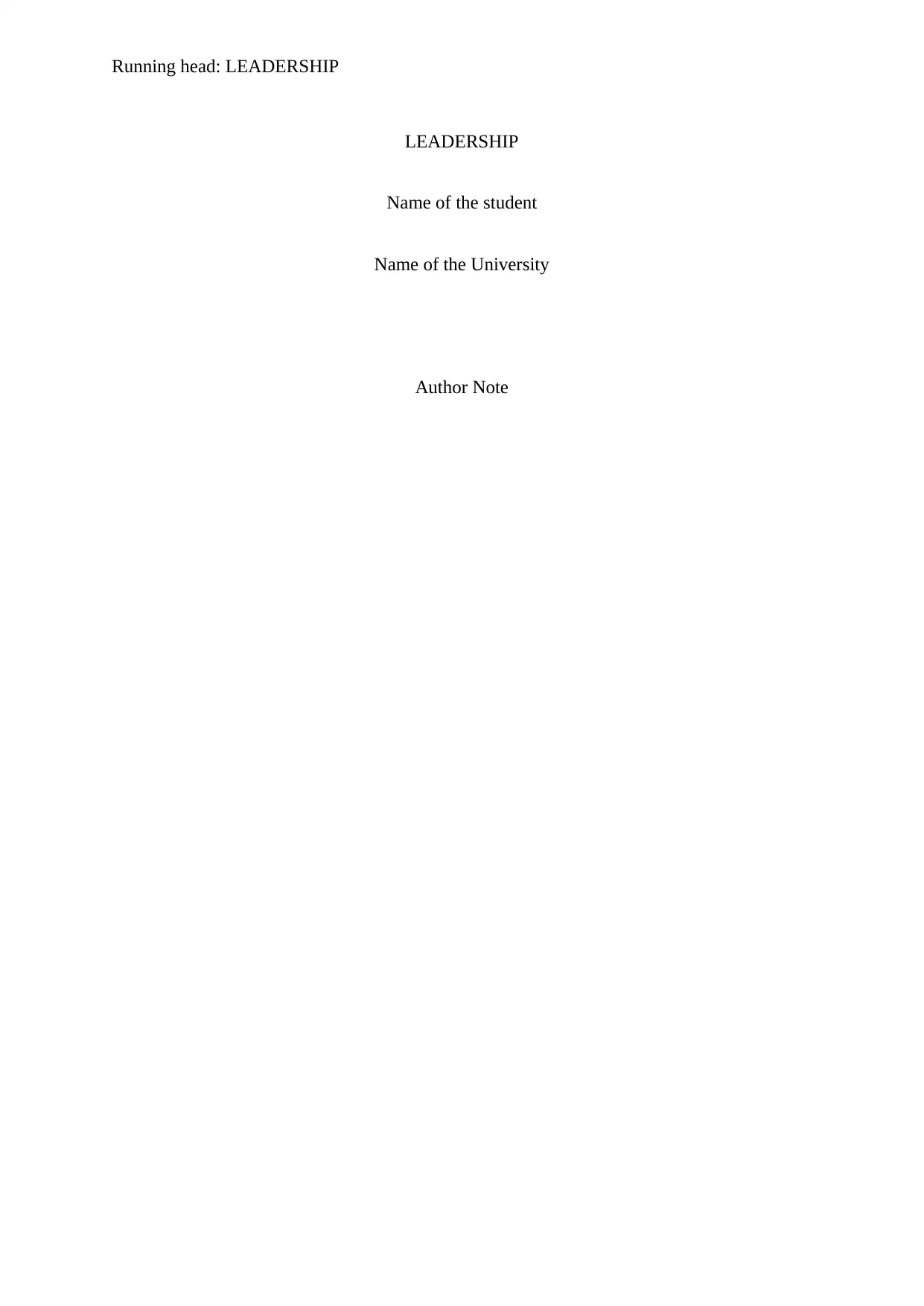
Running head: LEADERSHIP
LEADERSHIP
Name of the student
Name of the University
Author Note
LEADERSHIP
Name of the student
Name of the University
Author Note
Paraphrase This Document
Need a fresh take? Get an instant paraphrase of this document with our AI Paraphraser
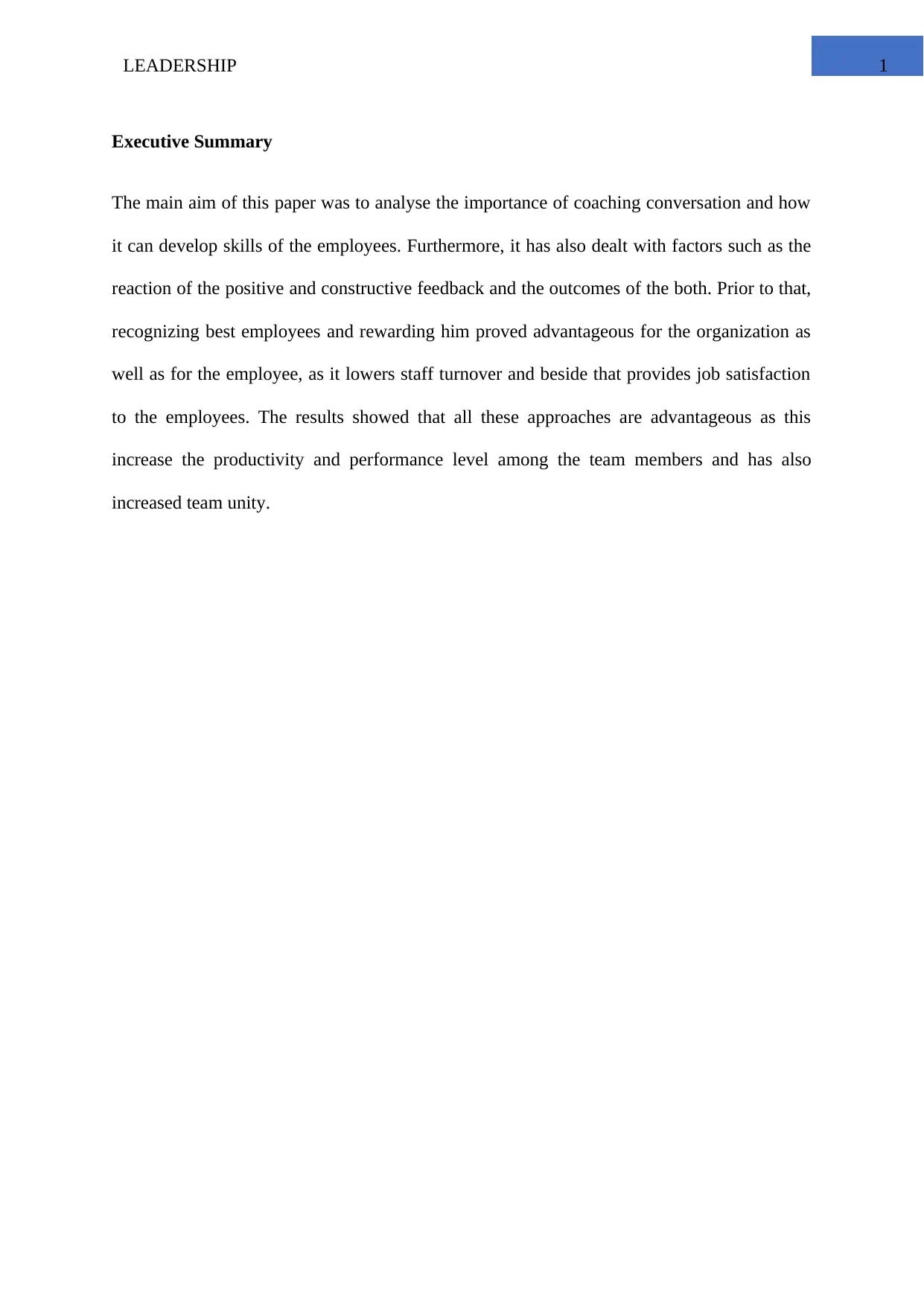
1LEADERSHIP
Executive Summary
The main aim of this paper was to analyse the importance of coaching conversation and how
it can develop skills of the employees. Furthermore, it has also dealt with factors such as the
reaction of the positive and constructive feedback and the outcomes of the both. Prior to that,
recognizing best employees and rewarding him proved advantageous for the organization as
well as for the employee, as it lowers staff turnover and beside that provides job satisfaction
to the employees. The results showed that all these approaches are advantageous as this
increase the productivity and performance level among the team members and has also
increased team unity.
Executive Summary
The main aim of this paper was to analyse the importance of coaching conversation and how
it can develop skills of the employees. Furthermore, it has also dealt with factors such as the
reaction of the positive and constructive feedback and the outcomes of the both. Prior to that,
recognizing best employees and rewarding him proved advantageous for the organization as
well as for the employee, as it lowers staff turnover and beside that provides job satisfaction
to the employees. The results showed that all these approaches are advantageous as this
increase the productivity and performance level among the team members and has also
increased team unity.
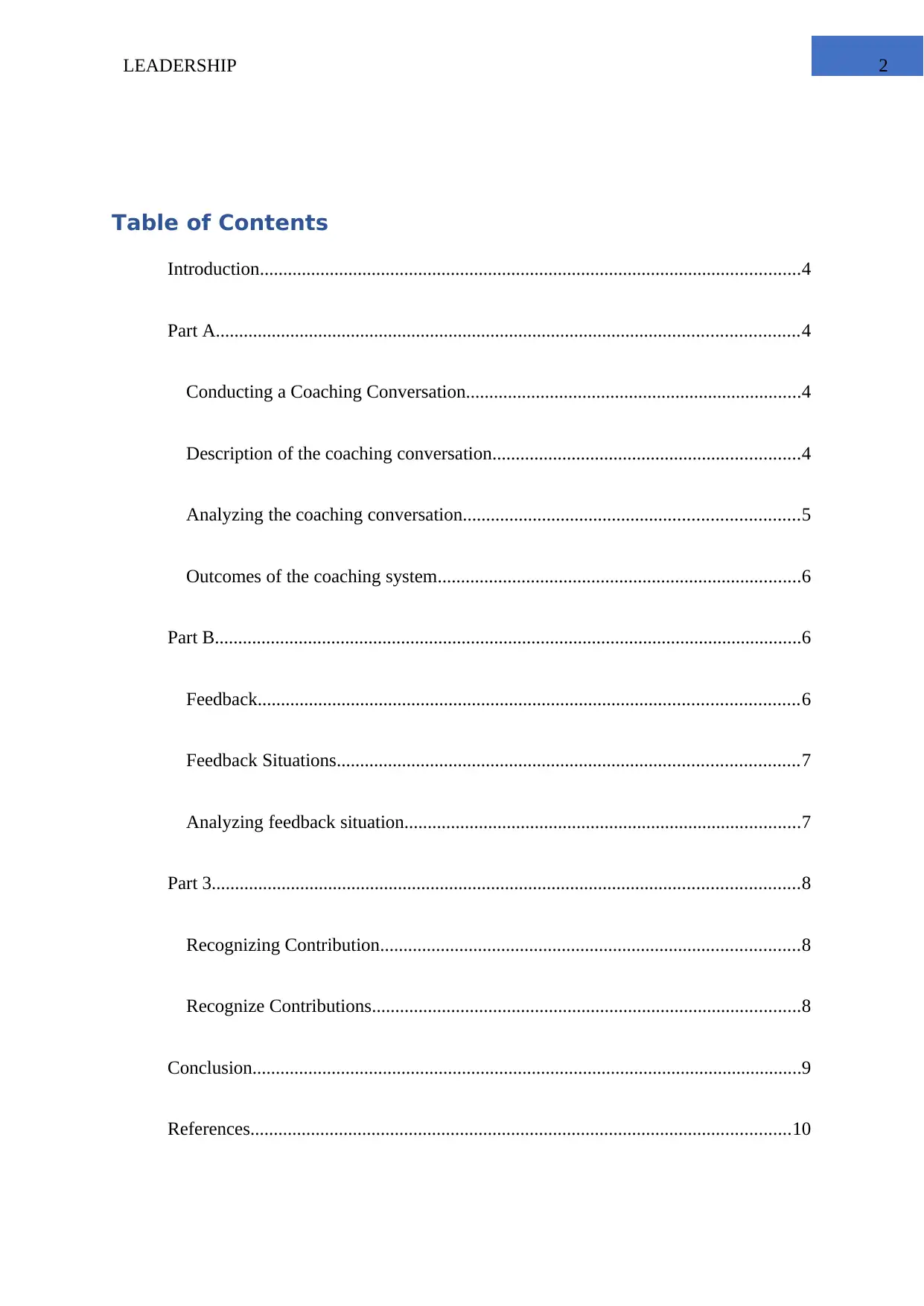
2LEADERSHIP
Table of Contents
Introduction....................................................................................................................4
Part A.............................................................................................................................4
Conducting a Coaching Conversation........................................................................4
Description of the coaching conversation..................................................................4
Analyzing the coaching conversation........................................................................5
Outcomes of the coaching system..............................................................................6
Part B..............................................................................................................................6
Feedback....................................................................................................................6
Feedback Situations...................................................................................................7
Analyzing feedback situation.....................................................................................7
Part 3..............................................................................................................................8
Recognizing Contribution..........................................................................................8
Recognize Contributions............................................................................................8
Conclusion......................................................................................................................9
References....................................................................................................................10
Table of Contents
Introduction....................................................................................................................4
Part A.............................................................................................................................4
Conducting a Coaching Conversation........................................................................4
Description of the coaching conversation..................................................................4
Analyzing the coaching conversation........................................................................5
Outcomes of the coaching system..............................................................................6
Part B..............................................................................................................................6
Feedback....................................................................................................................6
Feedback Situations...................................................................................................7
Analyzing feedback situation.....................................................................................7
Part 3..............................................................................................................................8
Recognizing Contribution..........................................................................................8
Recognize Contributions............................................................................................8
Conclusion......................................................................................................................9
References....................................................................................................................10
⊘ This is a preview!⊘
Do you want full access?
Subscribe today to unlock all pages.

Trusted by 1+ million students worldwide
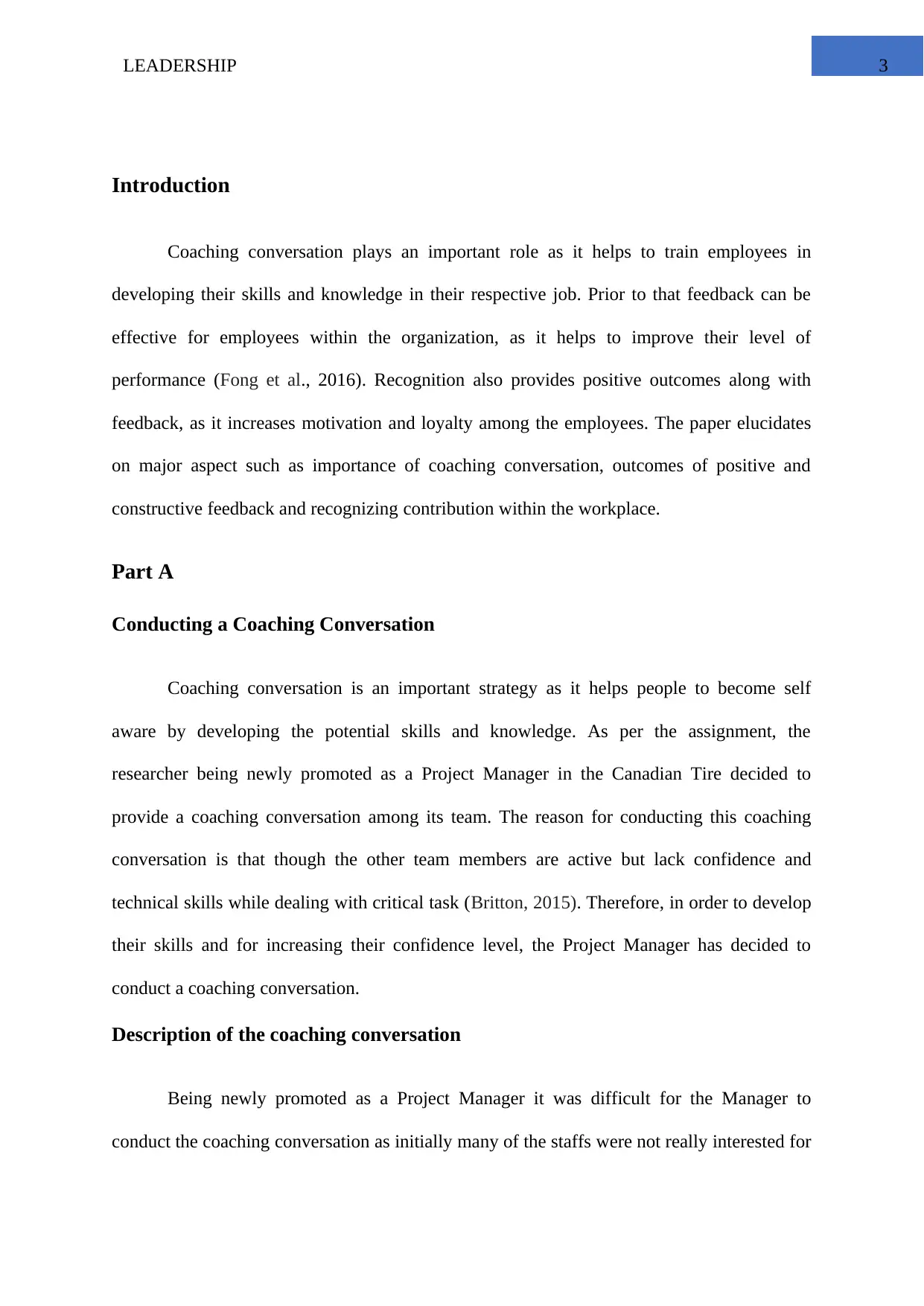
3LEADERSHIP
Introduction
Coaching conversation plays an important role as it helps to train employees in
developing their skills and knowledge in their respective job. Prior to that feedback can be
effective for employees within the organization, as it helps to improve their level of
performance (Fong et al., 2016). Recognition also provides positive outcomes along with
feedback, as it increases motivation and loyalty among the employees. The paper elucidates
on major aspect such as importance of coaching conversation, outcomes of positive and
constructive feedback and recognizing contribution within the workplace.
Part A
Conducting a Coaching Conversation
Coaching conversation is an important strategy as it helps people to become self
aware by developing the potential skills and knowledge. As per the assignment, the
researcher being newly promoted as a Project Manager in the Canadian Tire decided to
provide a coaching conversation among its team. The reason for conducting this coaching
conversation is that though the other team members are active but lack confidence and
technical skills while dealing with critical task (Britton, 2015). Therefore, in order to develop
their skills and for increasing their confidence level, the Project Manager has decided to
conduct a coaching conversation.
Description of the coaching conversation
Being newly promoted as a Project Manager it was difficult for the Manager to
conduct the coaching conversation as initially many of the staffs were not really interested for
Introduction
Coaching conversation plays an important role as it helps to train employees in
developing their skills and knowledge in their respective job. Prior to that feedback can be
effective for employees within the organization, as it helps to improve their level of
performance (Fong et al., 2016). Recognition also provides positive outcomes along with
feedback, as it increases motivation and loyalty among the employees. The paper elucidates
on major aspect such as importance of coaching conversation, outcomes of positive and
constructive feedback and recognizing contribution within the workplace.
Part A
Conducting a Coaching Conversation
Coaching conversation is an important strategy as it helps people to become self
aware by developing the potential skills and knowledge. As per the assignment, the
researcher being newly promoted as a Project Manager in the Canadian Tire decided to
provide a coaching conversation among its team. The reason for conducting this coaching
conversation is that though the other team members are active but lack confidence and
technical skills while dealing with critical task (Britton, 2015). Therefore, in order to develop
their skills and for increasing their confidence level, the Project Manager has decided to
conduct a coaching conversation.
Description of the coaching conversation
Being newly promoted as a Project Manager it was difficult for the Manager to
conduct the coaching conversation as initially many of the staffs were not really interested for
Paraphrase This Document
Need a fresh take? Get an instant paraphrase of this document with our AI Paraphraser
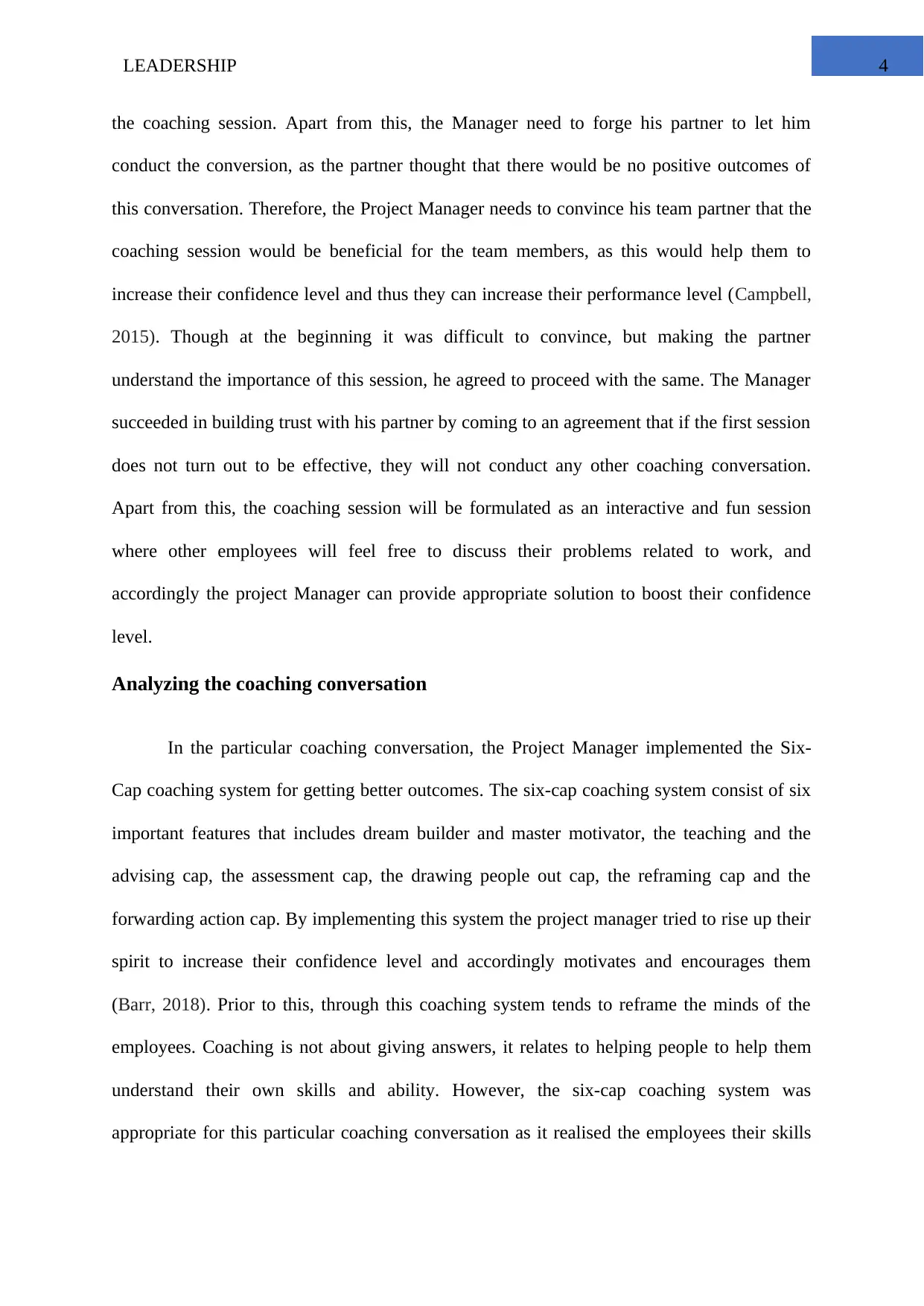
4LEADERSHIP
the coaching session. Apart from this, the Manager need to forge his partner to let him
conduct the conversion, as the partner thought that there would be no positive outcomes of
this conversation. Therefore, the Project Manager needs to convince his team partner that the
coaching session would be beneficial for the team members, as this would help them to
increase their confidence level and thus they can increase their performance level (Campbell,
2015). Though at the beginning it was difficult to convince, but making the partner
understand the importance of this session, he agreed to proceed with the same. The Manager
succeeded in building trust with his partner by coming to an agreement that if the first session
does not turn out to be effective, they will not conduct any other coaching conversation.
Apart from this, the coaching session will be formulated as an interactive and fun session
where other employees will feel free to discuss their problems related to work, and
accordingly the project Manager can provide appropriate solution to boost their confidence
level.
Analyzing the coaching conversation
In the particular coaching conversation, the Project Manager implemented the Six-
Cap coaching system for getting better outcomes. The six-cap coaching system consist of six
important features that includes dream builder and master motivator, the teaching and the
advising cap, the assessment cap, the drawing people out cap, the reframing cap and the
forwarding action cap. By implementing this system the project manager tried to rise up their
spirit to increase their confidence level and accordingly motivates and encourages them
(Barr, 2018). Prior to this, through this coaching system tends to reframe the minds of the
employees. Coaching is not about giving answers, it relates to helping people to help them
understand their own skills and ability. However, the six-cap coaching system was
appropriate for this particular coaching conversation as it realised the employees their skills
the coaching session. Apart from this, the Manager need to forge his partner to let him
conduct the conversion, as the partner thought that there would be no positive outcomes of
this conversation. Therefore, the Project Manager needs to convince his team partner that the
coaching session would be beneficial for the team members, as this would help them to
increase their confidence level and thus they can increase their performance level (Campbell,
2015). Though at the beginning it was difficult to convince, but making the partner
understand the importance of this session, he agreed to proceed with the same. The Manager
succeeded in building trust with his partner by coming to an agreement that if the first session
does not turn out to be effective, they will not conduct any other coaching conversation.
Apart from this, the coaching session will be formulated as an interactive and fun session
where other employees will feel free to discuss their problems related to work, and
accordingly the project Manager can provide appropriate solution to boost their confidence
level.
Analyzing the coaching conversation
In the particular coaching conversation, the Project Manager implemented the Six-
Cap coaching system for getting better outcomes. The six-cap coaching system consist of six
important features that includes dream builder and master motivator, the teaching and the
advising cap, the assessment cap, the drawing people out cap, the reframing cap and the
forwarding action cap. By implementing this system the project manager tried to rise up their
spirit to increase their confidence level and accordingly motivates and encourages them
(Barr, 2018). Prior to this, through this coaching system tends to reframe the minds of the
employees. Coaching is not about giving answers, it relates to helping people to help them
understand their own skills and ability. However, the six-cap coaching system was
appropriate for this particular coaching conversation as it realised the employees their skills
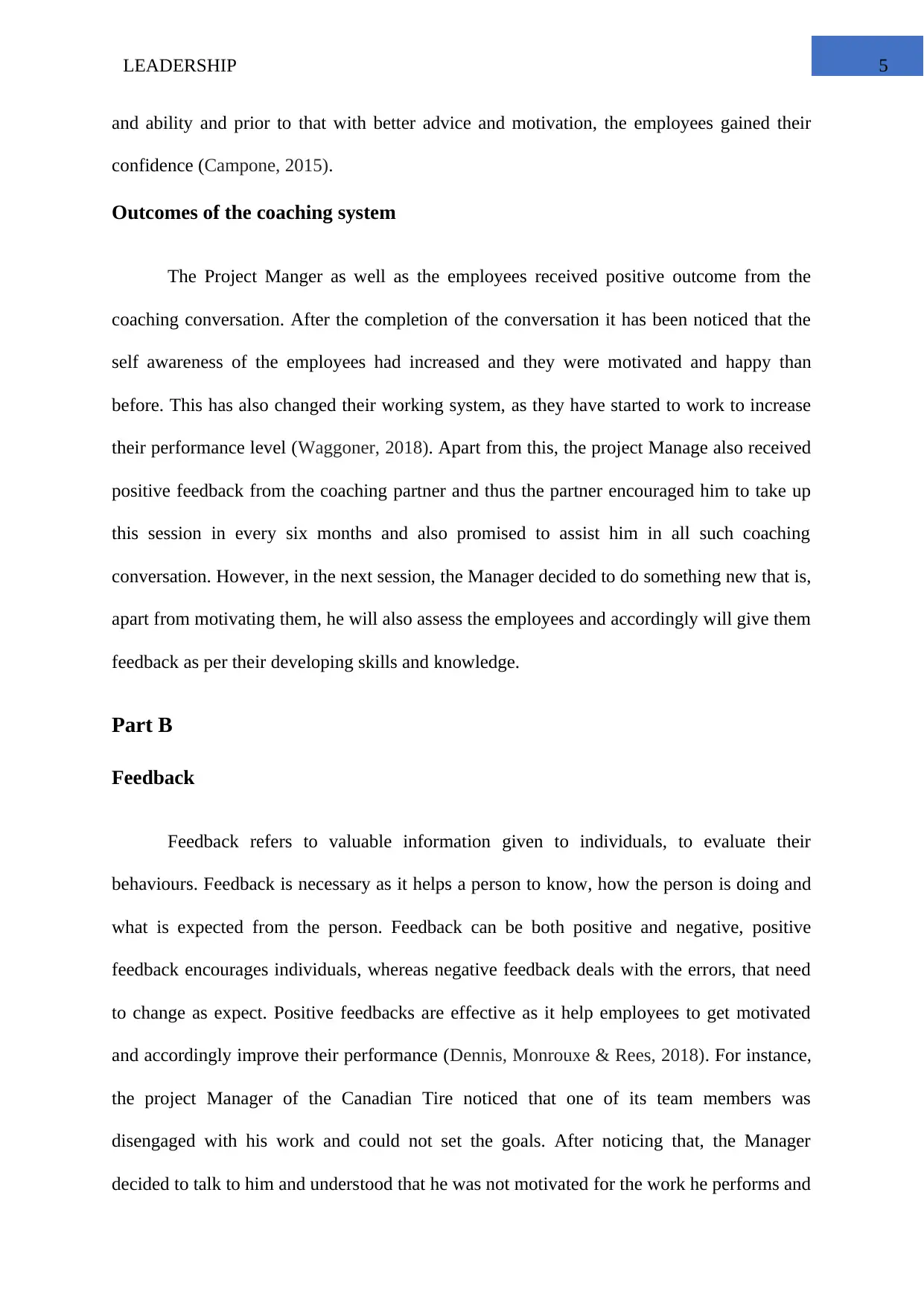
5LEADERSHIP
and ability and prior to that with better advice and motivation, the employees gained their
confidence (Campone, 2015).
Outcomes of the coaching system
The Project Manger as well as the employees received positive outcome from the
coaching conversation. After the completion of the conversation it has been noticed that the
self awareness of the employees had increased and they were motivated and happy than
before. This has also changed their working system, as they have started to work to increase
their performance level (Waggoner, 2018). Apart from this, the project Manage also received
positive feedback from the coaching partner and thus the partner encouraged him to take up
this session in every six months and also promised to assist him in all such coaching
conversation. However, in the next session, the Manager decided to do something new that is,
apart from motivating them, he will also assess the employees and accordingly will give them
feedback as per their developing skills and knowledge.
Part B
Feedback
Feedback refers to valuable information given to individuals, to evaluate their
behaviours. Feedback is necessary as it helps a person to know, how the person is doing and
what is expected from the person. Feedback can be both positive and negative, positive
feedback encourages individuals, whereas negative feedback deals with the errors, that need
to change as expect. Positive feedbacks are effective as it help employees to get motivated
and accordingly improve their performance (Dennis, Monrouxe & Rees, 2018). For instance,
the project Manager of the Canadian Tire noticed that one of its team members was
disengaged with his work and could not set the goals. After noticing that, the Manager
decided to talk to him and understood that he was not motivated for the work he performs and
and ability and prior to that with better advice and motivation, the employees gained their
confidence (Campone, 2015).
Outcomes of the coaching system
The Project Manger as well as the employees received positive outcome from the
coaching conversation. After the completion of the conversation it has been noticed that the
self awareness of the employees had increased and they were motivated and happy than
before. This has also changed their working system, as they have started to work to increase
their performance level (Waggoner, 2018). Apart from this, the project Manage also received
positive feedback from the coaching partner and thus the partner encouraged him to take up
this session in every six months and also promised to assist him in all such coaching
conversation. However, in the next session, the Manager decided to do something new that is,
apart from motivating them, he will also assess the employees and accordingly will give them
feedback as per their developing skills and knowledge.
Part B
Feedback
Feedback refers to valuable information given to individuals, to evaluate their
behaviours. Feedback is necessary as it helps a person to know, how the person is doing and
what is expected from the person. Feedback can be both positive and negative, positive
feedback encourages individuals, whereas negative feedback deals with the errors, that need
to change as expect. Positive feedbacks are effective as it help employees to get motivated
and accordingly improve their performance (Dennis, Monrouxe & Rees, 2018). For instance,
the project Manager of the Canadian Tire noticed that one of its team members was
disengaged with his work and could not set the goals. After noticing that, the Manager
decided to talk to him and understood that he was not motivated for the work he performs and
⊘ This is a preview!⊘
Do you want full access?
Subscribe today to unlock all pages.

Trusted by 1+ million students worldwide
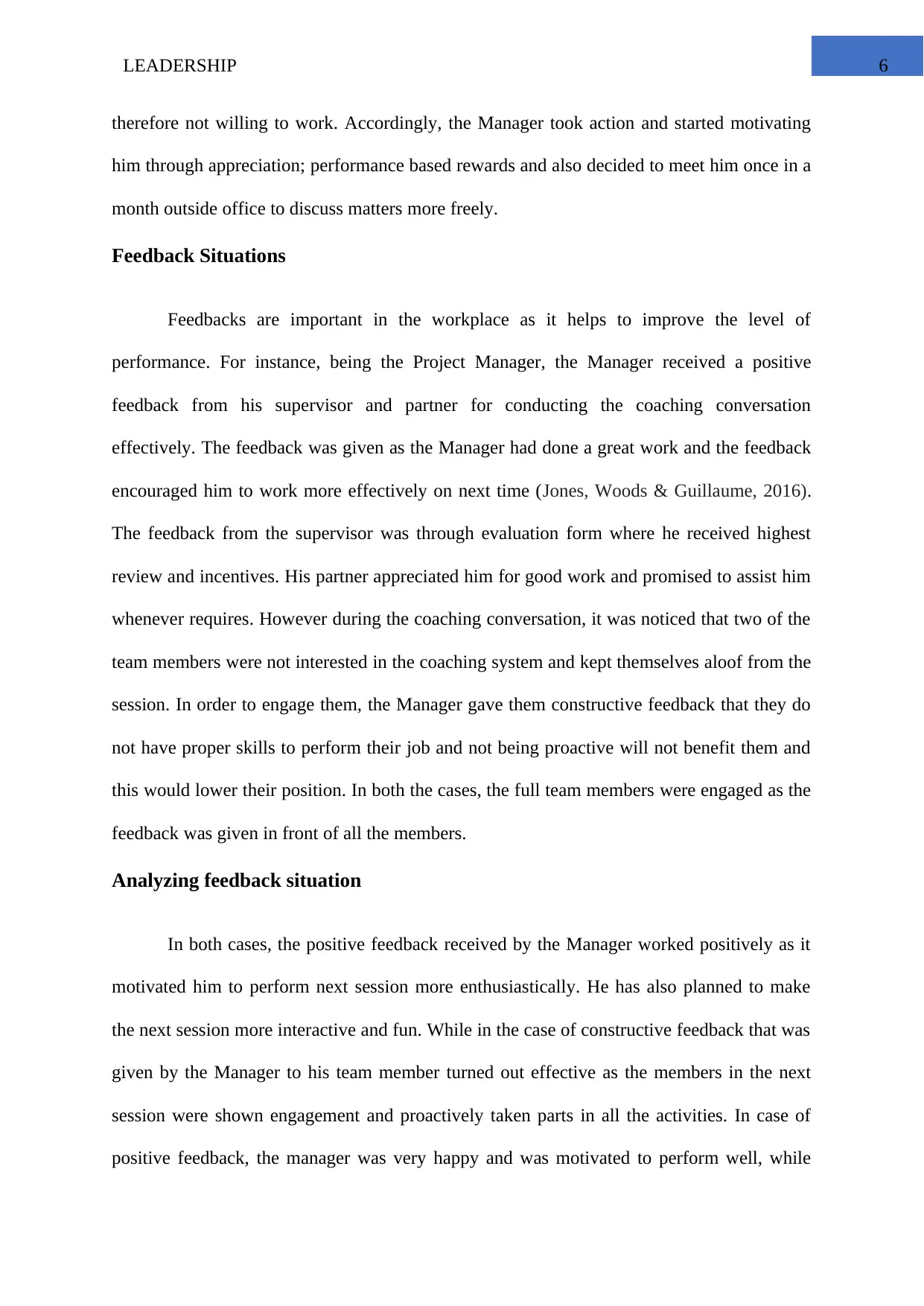
6LEADERSHIP
therefore not willing to work. Accordingly, the Manager took action and started motivating
him through appreciation; performance based rewards and also decided to meet him once in a
month outside office to discuss matters more freely.
Feedback Situations
Feedbacks are important in the workplace as it helps to improve the level of
performance. For instance, being the Project Manager, the Manager received a positive
feedback from his supervisor and partner for conducting the coaching conversation
effectively. The feedback was given as the Manager had done a great work and the feedback
encouraged him to work more effectively on next time (Jones, Woods & Guillaume, 2016).
The feedback from the supervisor was through evaluation form where he received highest
review and incentives. His partner appreciated him for good work and promised to assist him
whenever requires. However during the coaching conversation, it was noticed that two of the
team members were not interested in the coaching system and kept themselves aloof from the
session. In order to engage them, the Manager gave them constructive feedback that they do
not have proper skills to perform their job and not being proactive will not benefit them and
this would lower their position. In both the cases, the full team members were engaged as the
feedback was given in front of all the members.
Analyzing feedback situation
In both cases, the positive feedback received by the Manager worked positively as it
motivated him to perform next session more enthusiastically. He has also planned to make
the next session more interactive and fun. While in the case of constructive feedback that was
given by the Manager to his team member turned out effective as the members in the next
session were shown engagement and proactively taken parts in all the activities. In case of
positive feedback, the manager was very happy and was motivated to perform well, while
therefore not willing to work. Accordingly, the Manager took action and started motivating
him through appreciation; performance based rewards and also decided to meet him once in a
month outside office to discuss matters more freely.
Feedback Situations
Feedbacks are important in the workplace as it helps to improve the level of
performance. For instance, being the Project Manager, the Manager received a positive
feedback from his supervisor and partner for conducting the coaching conversation
effectively. The feedback was given as the Manager had done a great work and the feedback
encouraged him to work more effectively on next time (Jones, Woods & Guillaume, 2016).
The feedback from the supervisor was through evaluation form where he received highest
review and incentives. His partner appreciated him for good work and promised to assist him
whenever requires. However during the coaching conversation, it was noticed that two of the
team members were not interested in the coaching system and kept themselves aloof from the
session. In order to engage them, the Manager gave them constructive feedback that they do
not have proper skills to perform their job and not being proactive will not benefit them and
this would lower their position. In both the cases, the full team members were engaged as the
feedback was given in front of all the members.
Analyzing feedback situation
In both cases, the positive feedback received by the Manager worked positively as it
motivated him to perform next session more enthusiastically. He has also planned to make
the next session more interactive and fun. While in the case of constructive feedback that was
given by the Manager to his team member turned out effective as the members in the next
session were shown engagement and proactively taken parts in all the activities. In case of
positive feedback, the manager was very happy and was motivated to perform well, while
Paraphrase This Document
Need a fresh take? Get an instant paraphrase of this document with our AI Paraphraser
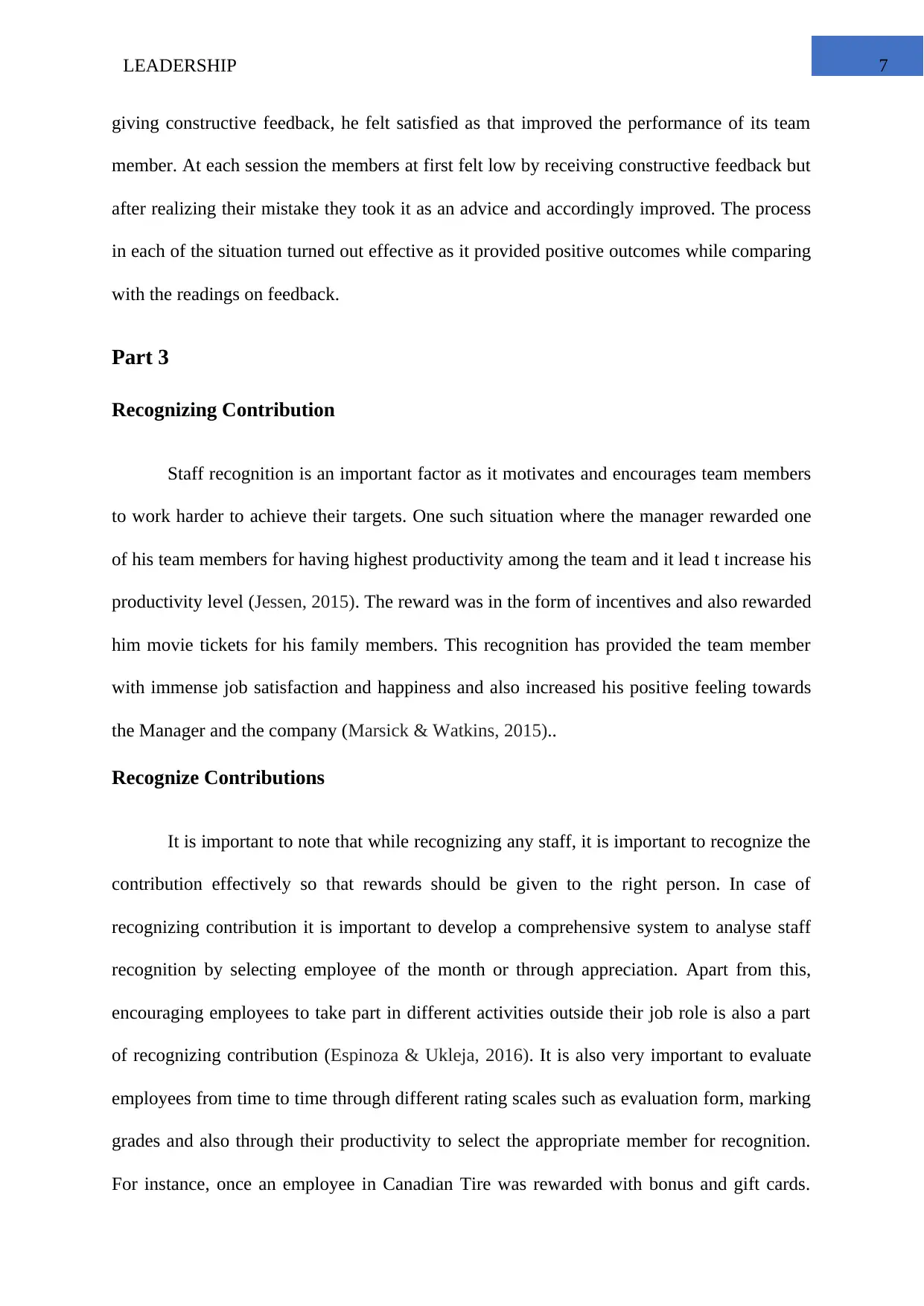
7LEADERSHIP
giving constructive feedback, he felt satisfied as that improved the performance of its team
member. At each session the members at first felt low by receiving constructive feedback but
after realizing their mistake they took it as an advice and accordingly improved. The process
in each of the situation turned out effective as it provided positive outcomes while comparing
with the readings on feedback.
Part 3
Recognizing Contribution
Staff recognition is an important factor as it motivates and encourages team members
to work harder to achieve their targets. One such situation where the manager rewarded one
of his team members for having highest productivity among the team and it lead t increase his
productivity level (Jessen, 2015). The reward was in the form of incentives and also rewarded
him movie tickets for his family members. This recognition has provided the team member
with immense job satisfaction and happiness and also increased his positive feeling towards
the Manager and the company (Marsick & Watkins, 2015)..
Recognize Contributions
It is important to note that while recognizing any staff, it is important to recognize the
contribution effectively so that rewards should be given to the right person. In case of
recognizing contribution it is important to develop a comprehensive system to analyse staff
recognition by selecting employee of the month or through appreciation. Apart from this,
encouraging employees to take part in different activities outside their job role is also a part
of recognizing contribution (Espinoza & Ukleja, 2016). It is also very important to evaluate
employees from time to time through different rating scales such as evaluation form, marking
grades and also through their productivity to select the appropriate member for recognition.
For instance, once an employee in Canadian Tire was rewarded with bonus and gift cards.
giving constructive feedback, he felt satisfied as that improved the performance of its team
member. At each session the members at first felt low by receiving constructive feedback but
after realizing their mistake they took it as an advice and accordingly improved. The process
in each of the situation turned out effective as it provided positive outcomes while comparing
with the readings on feedback.
Part 3
Recognizing Contribution
Staff recognition is an important factor as it motivates and encourages team members
to work harder to achieve their targets. One such situation where the manager rewarded one
of his team members for having highest productivity among the team and it lead t increase his
productivity level (Jessen, 2015). The reward was in the form of incentives and also rewarded
him movie tickets for his family members. This recognition has provided the team member
with immense job satisfaction and happiness and also increased his positive feeling towards
the Manager and the company (Marsick & Watkins, 2015)..
Recognize Contributions
It is important to note that while recognizing any staff, it is important to recognize the
contribution effectively so that rewards should be given to the right person. In case of
recognizing contribution it is important to develop a comprehensive system to analyse staff
recognition by selecting employee of the month or through appreciation. Apart from this,
encouraging employees to take part in different activities outside their job role is also a part
of recognizing contribution (Espinoza & Ukleja, 2016). It is also very important to evaluate
employees from time to time through different rating scales such as evaluation form, marking
grades and also through their productivity to select the appropriate member for recognition.
For instance, once an employee in Canadian Tire was rewarded with bonus and gift cards.
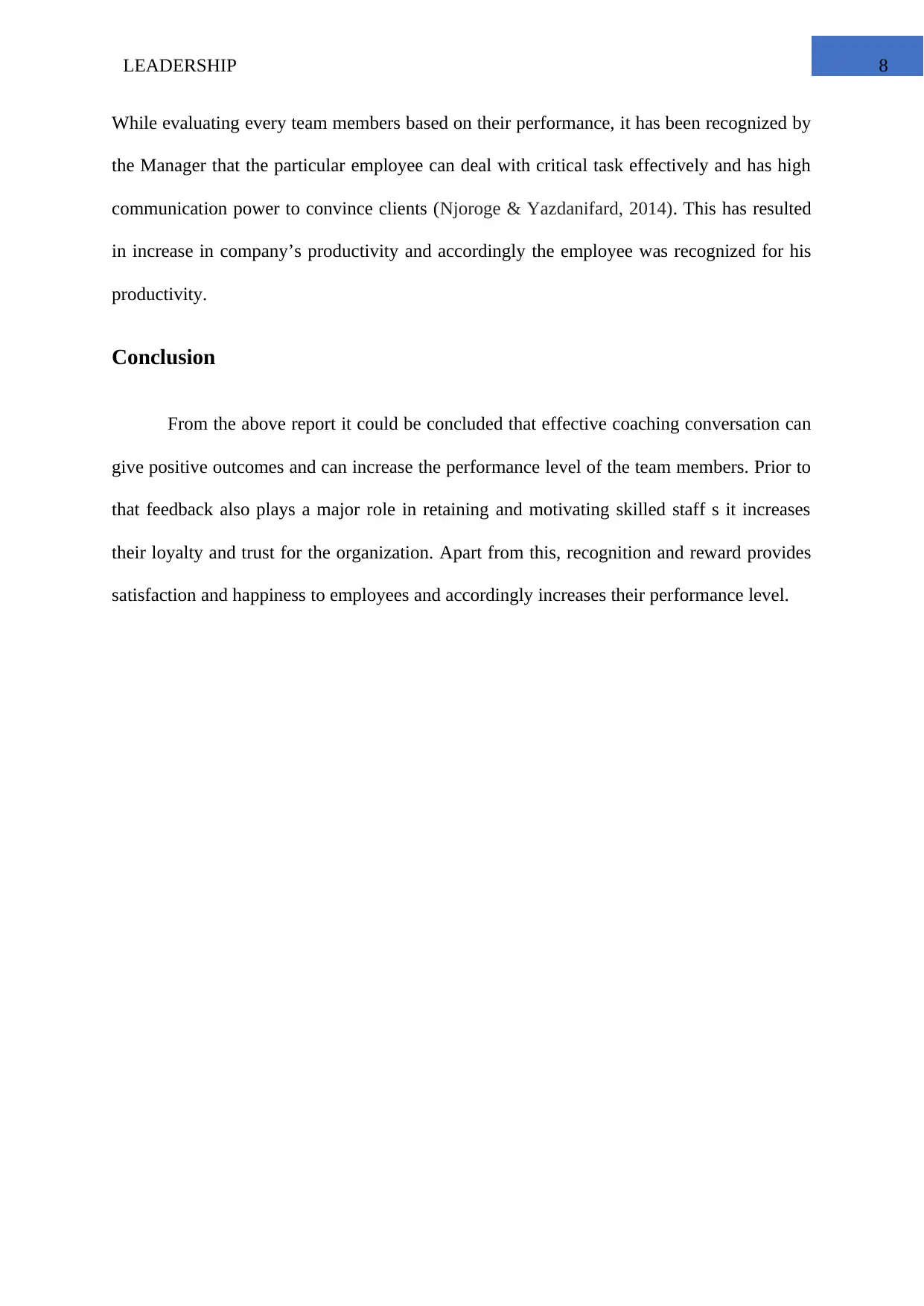
8LEADERSHIP
While evaluating every team members based on their performance, it has been recognized by
the Manager that the particular employee can deal with critical task effectively and has high
communication power to convince clients (Njoroge & Yazdanifard, 2014). This has resulted
in increase in company’s productivity and accordingly the employee was recognized for his
productivity.
Conclusion
From the above report it could be concluded that effective coaching conversation can
give positive outcomes and can increase the performance level of the team members. Prior to
that feedback also plays a major role in retaining and motivating skilled staff s it increases
their loyalty and trust for the organization. Apart from this, recognition and reward provides
satisfaction and happiness to employees and accordingly increases their performance level.
While evaluating every team members based on their performance, it has been recognized by
the Manager that the particular employee can deal with critical task effectively and has high
communication power to convince clients (Njoroge & Yazdanifard, 2014). This has resulted
in increase in company’s productivity and accordingly the employee was recognized for his
productivity.
Conclusion
From the above report it could be concluded that effective coaching conversation can
give positive outcomes and can increase the performance level of the team members. Prior to
that feedback also plays a major role in retaining and motivating skilled staff s it increases
their loyalty and trust for the organization. Apart from this, recognition and reward provides
satisfaction and happiness to employees and accordingly increases their performance level.
⊘ This is a preview!⊘
Do you want full access?
Subscribe today to unlock all pages.

Trusted by 1+ million students worldwide
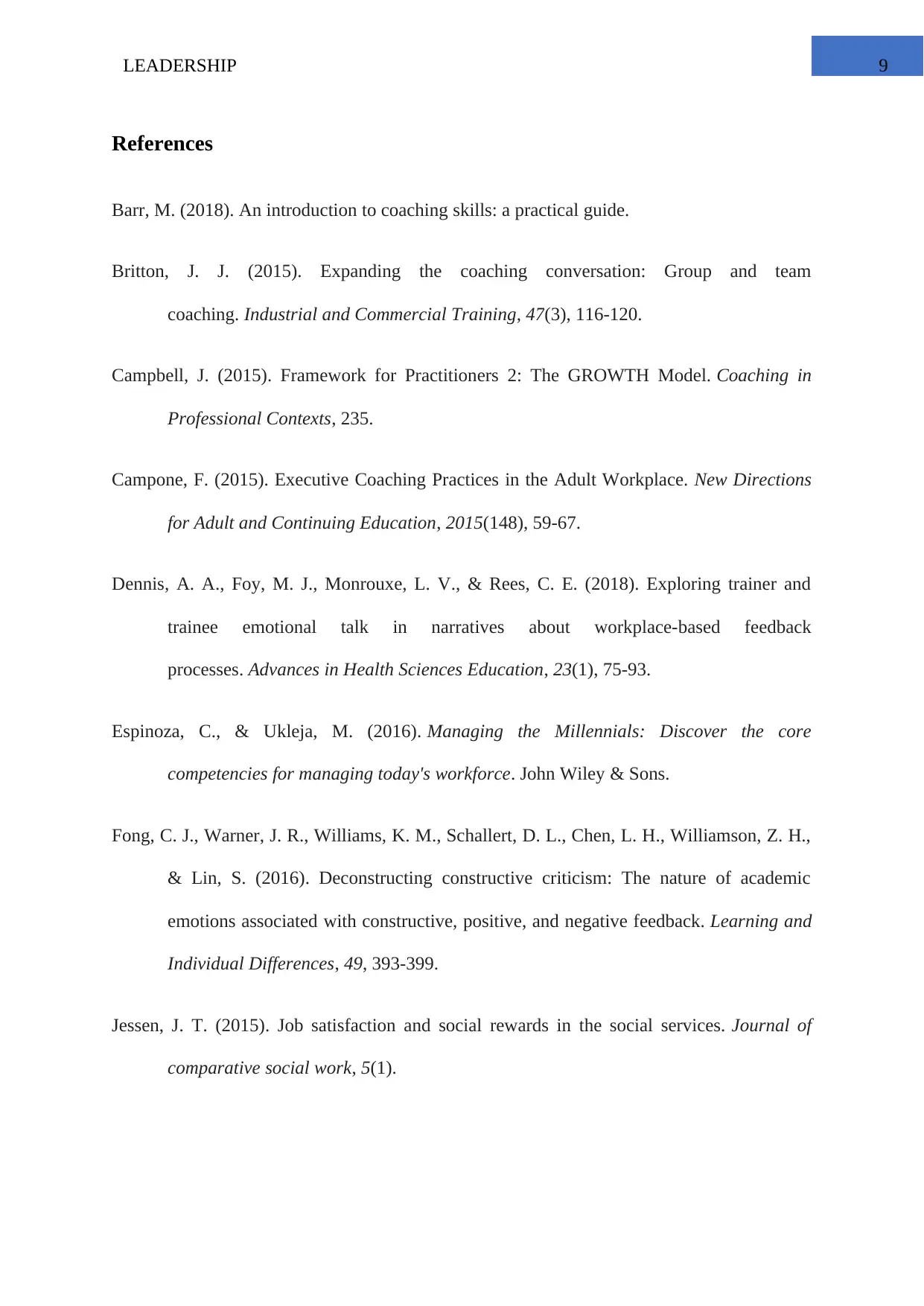
9LEADERSHIP
References
Barr, M. (2018). An introduction to coaching skills: a practical guide.
Britton, J. J. (2015). Expanding the coaching conversation: Group and team
coaching. Industrial and Commercial Training, 47(3), 116-120.
Campbell, J. (2015). Framework for Practitioners 2: The GROWTH Model. Coaching in
Professional Contexts, 235.
Campone, F. (2015). Executive Coaching Practices in the Adult Workplace. New Directions
for Adult and Continuing Education, 2015(148), 59-67.
Dennis, A. A., Foy, M. J., Monrouxe, L. V., & Rees, C. E. (2018). Exploring trainer and
trainee emotional talk in narratives about workplace-based feedback
processes. Advances in Health Sciences Education, 23(1), 75-93.
Espinoza, C., & Ukleja, M. (2016). Managing the Millennials: Discover the core
competencies for managing today's workforce. John Wiley & Sons.
Fong, C. J., Warner, J. R., Williams, K. M., Schallert, D. L., Chen, L. H., Williamson, Z. H.,
& Lin, S. (2016). Deconstructing constructive criticism: The nature of academic
emotions associated with constructive, positive, and negative feedback. Learning and
Individual Differences, 49, 393-399.
Jessen, J. T. (2015). Job satisfaction and social rewards in the social services. Journal of
comparative social work, 5(1).
References
Barr, M. (2018). An introduction to coaching skills: a practical guide.
Britton, J. J. (2015). Expanding the coaching conversation: Group and team
coaching. Industrial and Commercial Training, 47(3), 116-120.
Campbell, J. (2015). Framework for Practitioners 2: The GROWTH Model. Coaching in
Professional Contexts, 235.
Campone, F. (2015). Executive Coaching Practices in the Adult Workplace. New Directions
for Adult and Continuing Education, 2015(148), 59-67.
Dennis, A. A., Foy, M. J., Monrouxe, L. V., & Rees, C. E. (2018). Exploring trainer and
trainee emotional talk in narratives about workplace-based feedback
processes. Advances in Health Sciences Education, 23(1), 75-93.
Espinoza, C., & Ukleja, M. (2016). Managing the Millennials: Discover the core
competencies for managing today's workforce. John Wiley & Sons.
Fong, C. J., Warner, J. R., Williams, K. M., Schallert, D. L., Chen, L. H., Williamson, Z. H.,
& Lin, S. (2016). Deconstructing constructive criticism: The nature of academic
emotions associated with constructive, positive, and negative feedback. Learning and
Individual Differences, 49, 393-399.
Jessen, J. T. (2015). Job satisfaction and social rewards in the social services. Journal of
comparative social work, 5(1).
Paraphrase This Document
Need a fresh take? Get an instant paraphrase of this document with our AI Paraphraser
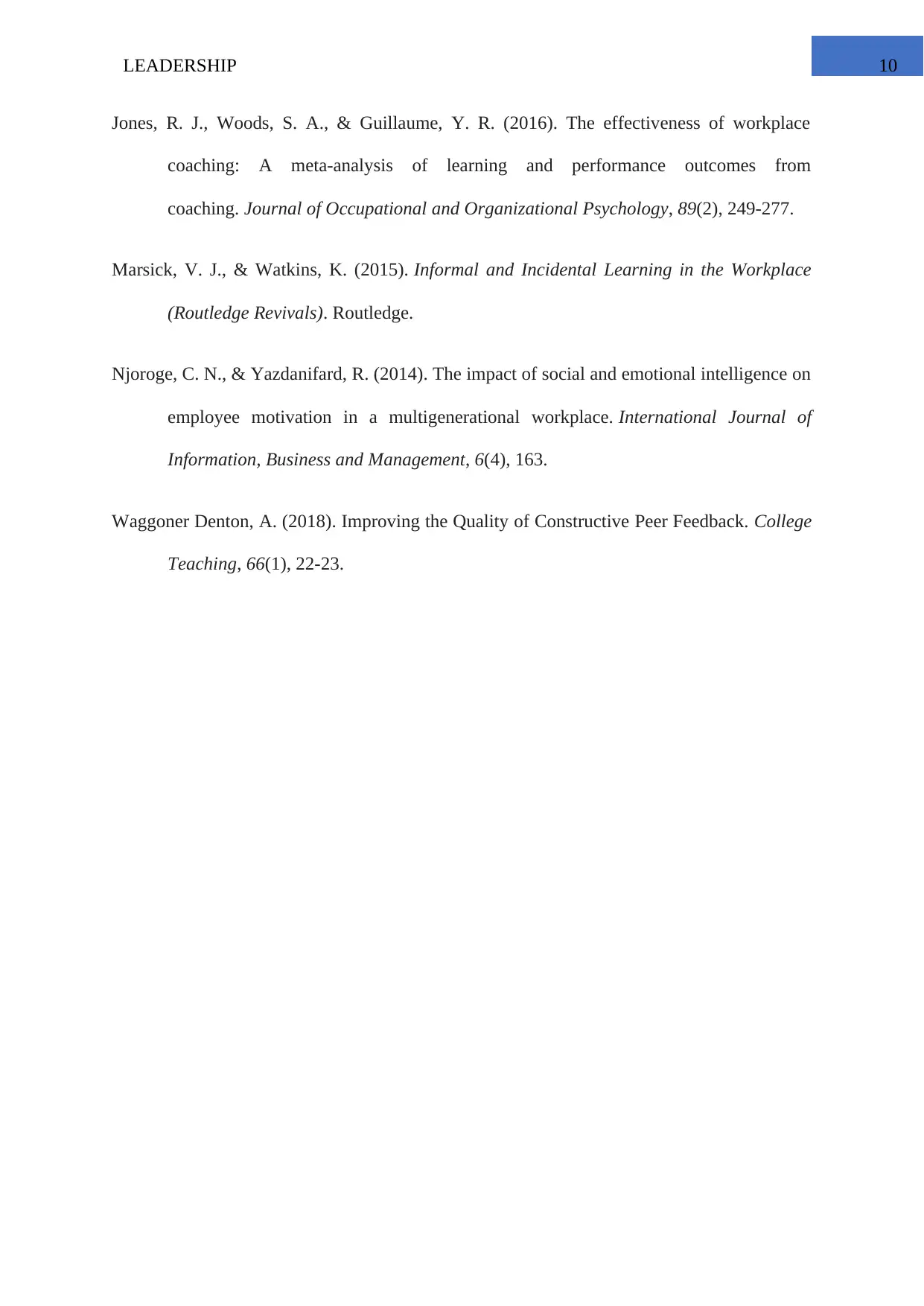
10LEADERSHIP
Jones, R. J., Woods, S. A., & Guillaume, Y. R. (2016). The effectiveness of workplace
coaching: A meta‐analysis of learning and performance outcomes from
coaching. Journal of Occupational and Organizational Psychology, 89(2), 249-277.
Marsick, V. J., & Watkins, K. (2015). Informal and Incidental Learning in the Workplace
(Routledge Revivals). Routledge.
Njoroge, C. N., & Yazdanifard, R. (2014). The impact of social and emotional intelligence on
employee motivation in a multigenerational workplace. International Journal of
Information, Business and Management, 6(4), 163.
Waggoner Denton, A. (2018). Improving the Quality of Constructive Peer Feedback. College
Teaching, 66(1), 22-23.
Jones, R. J., Woods, S. A., & Guillaume, Y. R. (2016). The effectiveness of workplace
coaching: A meta‐analysis of learning and performance outcomes from
coaching. Journal of Occupational and Organizational Psychology, 89(2), 249-277.
Marsick, V. J., & Watkins, K. (2015). Informal and Incidental Learning in the Workplace
(Routledge Revivals). Routledge.
Njoroge, C. N., & Yazdanifard, R. (2014). The impact of social and emotional intelligence on
employee motivation in a multigenerational workplace. International Journal of
Information, Business and Management, 6(4), 163.
Waggoner Denton, A. (2018). Improving the Quality of Constructive Peer Feedback. College
Teaching, 66(1), 22-23.
1 out of 11
Related Documents
Your All-in-One AI-Powered Toolkit for Academic Success.
+13062052269
info@desklib.com
Available 24*7 on WhatsApp / Email
![[object Object]](/_next/static/media/star-bottom.7253800d.svg)
Unlock your academic potential
© 2024 | Zucol Services PVT LTD | All rights reserved.





